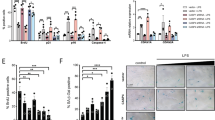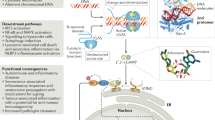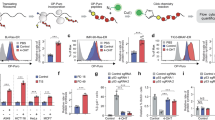Abstract
Cellular senescence is triggered by various distinct stresses and characterized by a permanent cell cycle arrest. Senescent cells secrete a variety of inflammatory factors, collectively referred to as the senescence-associated secretory phenotype (SASP). The mechanism(s) underlying the regulation of the SASP remains incompletely understood. Here we define a role for innate DNA sensing in the regulation of senescence and the SASP. We find that cyclic GMP-AMP synthase (cGAS) recognizes cytosolic chromatin fragments in senescent cells. The activation of cGAS, in turn, triggers the production of SASP factors via stimulator of interferon genes (STING), thereby promoting paracrine senescence. We demonstrate that diverse stimuli of cellular senescence engage the cGAS–STING pathway in vitro and we show cGAS-dependent regulation of senescence following irradiation and oncogene activation in vivo. Our findings provide insights into the mechanisms underlying cellular senescence by establishing the cGAS–STING pathway as a crucial regulator of senescence and the SASP.
This is a preview of subscription content, access via your institution
Access options
Access Nature and 54 other Nature Portfolio journals
Get Nature+, our best-value online-access subscription
$29.99 / 30 days
cancel any time
Subscribe to this journal
Receive 12 print issues and online access
$209.00 per year
only $17.42 per issue
Buy this article
- Purchase on SpringerLink
- Instant access to full article PDF
Prices may be subject to local taxes which are calculated during checkout






Similar content being viewed by others
Accession codes
References
Kuilman, T., Michaloglou, C., Mooi, W. J. & Peeper, D. S. The essence of senescence. Genes Dev. 24, 2463–2479 (2010).
Campisi, J. Aging, cellular senescence, and cancer. Annu. Rev. Physiol. 75, 685–705 (2013).
Coppe, J. P., Desprez, P. Y., Krtolica, A. & Campisi, J. The senescence-associated secretory phenotype: the dark side of tumor suppression. Annu. Rev. Pathol. 5, 99–118 (2010).
Tchkonia, T., Zhu, Y., van Deursen, J., Campisi, J. & Kirkland, J. L. Cellular senescence and the senescent secretory phenotype: therapeutic opportunities. J. Clin. Invest. 123, 966–972 (2013).
Demaria, M. et al. An essential role for senescent cells in optimal wound healing through secretion of PDGF-AA. Dev. Cell 31, 722–733 (2014).
Krizhanovsky, V. et al. Senescence of activated stellate cells limits liver fibrosis. Cell 134, 657–667 (2008).
Kang, T. W. et al. Senescence surveillance of pre-malignant hepatocytes limits liver cancer development. Nature 479, 547–551 (2011).
Mosteiro, L. et al. Tissue damage and senescence provide critical signals for cellular reprogramming in vivo. Science 354, aaf4445 (2016).
Baker, D. J. et al. Naturally occurring p16Ink4a-positive cells shorten healthy lifespan. Nature 530, 184–189 (2016).
Childs, B. G., Durik, M., Baker, D. J. & van Deursen, J. M. Cellular senescence in aging and age-related disease: from mechanisms to therapy. Nat. Med. 21, 1424–1435 (2015).
Lopez-Otin, C., Blasco, M. A., Partridge, L., Serrano, M. & Kroemer, G. The hallmarks of aging. Cell 153, 1194–1217 (2013).
Acosta, J. C. et al. Chemokine signaling via the CXCR2 receptor reinforces senescence. Cell 133, 1006–1018 (2008).
Kuilman, T. et al. Oncogene-induced senescence relayed by an interleukin-dependent inflammatory network. Cell 133, 1019–1031 (2008).
Chien, Y. et al. Control of the senescence-associated secretory phenotype by NF-κB promotes senescence and enhances chemosensitivity. Genes Dev. 25, 2125–2136 (2011).
Freund, A., Patil, C. K. & Campisi, J. p38MAPK is a novel DNA damage response-independent regulator of the senescence-associated secretory phenotype. EMBO J. 30, 1536–1548 (2011).
Kang, C. et al. The DNA damage response induces inflammation and senescence by inhibiting autophagy of GATA4. Science 349, aaa5612 (2015).
Takeuchi, O. & Akira, S. Pattern recognition receptors and inflammation. Cell 140, 805–820 (2010).
Sun, L., Wu, J., Du, F., Chen, X. & Chen, Z. J. Cyclic GMP-AMP synthase is a cytosolic DNA sensor that activates the type I interferon pathway. Science 339, 786–791 (2013).
Diner, E. J. et al. The innate immune DNA sensor cGAS produces a noncanonical cyclic dinucleotide that activates human STING. Cell Rep. 3, 1355–1361 (2013).
Ablasser, A. et al. cGAS produces a 2′-5′-linked cyclic dinucleotide second messenger that activates STING. Nature 498, 380–384 (2013).
Zhang, X. et al. Cyclic GMP-AMP containing mixed phosphodiester linkages is an endogenous high-affinity ligand for STING. Mol. Cell 51, 226–235 (2013).
Gao, P. et al. Cyclic [G(2′,5′)pA(3′,5′)p] is the metazoan second messenger produced by DNA-activated cyclic GMP-AMP synthase. Cell 153, 1094–1107 (2013).
Ablasser, A. & Gulen, M. F. The role of cGAS in innate immunity and beyond. J. Mol. Med. 94, 1085–1093 (2016).
Chen, Q., Sun, L. & Chen, Z. J. Regulation and function of the cGAS-STING pathway of cytosolic DNA sensing. Nat. Immunol. 17, 1142–1149 (2016).
Barber, G. N. STING: infection, inflammation and cancer. Nat. Rev. Immunol. 15, 760–770 (2015).
Gao, D. et al. Activation of cyclic GMP-AMP synthase by self-DNA causes autoimmune diseases. Proc. Natl Acad. Sci. USA 112, E5699–E5705 (2015).
Gray, E. E., Treuting, P. M., Woodward, J. J. & Stetson, D. B. Cutting edge: cGAS is required for lethal autoimmune disease in the Trex1-deficient mouse model of Aicardi-Goutieres syndrome. J. Immunol. 195, 1939–1943 (2015).
Ablasser, A. et al. TREX1 deficiency triggers cell-autonomous immunity in a cGAS-dependent manner. J. Immunol. 192, 5993–5997 (2014).
Crow, Y. J. & Manel, N. Aicardi-Goutieres syndrome and the type I interferonopathies. Nat. Rev. Immunol. 15, 429–440 (2015).
Deng, L. et al. STING-dependent cytosolic DNA sensing promotes radiation-induced type I interferon-dependent antitumor immunity in immunogenic tumors. Immunity 41, 843–852 (2014).
Ivanov, A. et al. Lysosome-mediated processing of chromatin in senescence. J. Cell Biol. 202, 129–143 (2013).
Xu, J. Preparation, culture, and immortalization of mouse embryonic fibroblasts. in Current Protocols in Molecular Biology (eds Frederick, M. A. et al.) Ch. 28, Unit 28.1 (2005).
Munoz-Espin, D. & Serrano, M. Cellular senescence: from physiology to pathology. Nat. Rev. Mol. Cell Biol. 15, 482–496 (2014).
Collado, M., Blasco, M. A. & Serrano, M. Cellular senescence in cancer and aging. Cell 130, 223–233 (2007).
Bracken, A. P., Ciro, M., Cocito, A. & Helin, K. E2F target genes: unraveling the biology. Trends Biochem. Sci. 29, 409–417 (2004).
Parrinello, S. et al. Oxygen sensitivity severely limits the replicative lifespan of murine fibroblasts. Nat. Cell Biol. 5, 741–747 (2003).
Coppe, J. P. et al. Senescence-associated secretory phenotypes reveal cell-nonautonomous functions of oncogenic RAS and the p53 tumor suppressor. PLoS Biol. 6, 2853–2868 (2008).
Acosta, J. C. et al. A complex secretory program orchestrated by the inflammasome controls paracrine senescence. Nat. Cell Biol. 15, 978–990 (2013).
Moiseeva, O., Mallette, F. A., Mukhopadhyay, U. K., Moores, A. & Ferbeyre, G. DNA damage signaling and p53-dependent senescence after prolonged β-interferon stimulation. Mol. Biol. Cell 17, 1583–1592 (2006).
Yu, Q. et al. DNA-damage-induced type I interferon promotes senescence and inhibits stem cell function. Cell Rep. 11, 785–797 (2015).
Katlinskaya, Y. V. et al. Suppression of type I interferon signaling overcomes oncogene-induced senescence and mediates melanoma development and progression. Cell Rep. 15, 171–180 (2016).
Braumuller, H. et al. T-helper-1-cell cytokines drive cancer into senescence. Nature 494, 361–365 (2013).
Freund, A., Laberge, R. M., Demaria, M. & Campisi, J. Lamin B1 loss is a senescence-associated biomarker. Mol. Biol. Cell 23, 2066–2075 (2012).
Le, O. N. et al. Ionizing radiation-induced long-term expression of senescence markers in mice is independent of p53 and immune status. Aging Cell 9, 398–409 (2010).
van Deursen, J. M. The role of senescent cells in ageing. Nature 509, 439–446 (2014).
Xue, W. et al. Senescence and tumour clearance is triggered by p53 restoration in murine liver carcinomas. Nature 445, 656–660 (2007).
Childs, B. G. et al. Senescent intimal foam cells are deleterious at all stages of atherosclerosis. Science 354, 472–477 (2016).
Jeon, O. H. et al. Local clearance of senescent cells attenuates the development of post-traumatic osteoarthritis and creates a pro-regenerative environment. Nat. Med. 23, 775–781 (2017).
Jin, L. et al. MPYS is required for IFN response factor 3 activation and type I IFN production in the response of cultured phagocytes to bacterial second messengers cyclic-di-AMP and cyclic-di-GMP. J. Immunol. 187, 2595–2601 (2011).
Bridgeman, A. et al. Viruses transfer the antiviral second messenger cGAMP between cells. Science 349, 1228–1232 (2015).
Muller, U. et al. Functional role of type I and type II interferons in antiviral defense. Science 264, 1918–1921 (1994).
McCloy, R. A. et al. Partial inhibition of Cdk1 in G 2 phase overrides the SAC and decouples mitotic events. Cell Cycle 13, 1400–1412 (2014).
Kang, T. W. et al. Senescence surveillance of pre-malignant hepatocytes limits liver cancer development. Nature 479, 547–551 (2011).
Krizhanovsky, V. et al. Senescence of activated stellate cells limits liver fibrosis. Cell 134, 657–667 (2008).
Acknowledgements
We thank N. Jordan for the preparation of viral particles, and B. Mangeat from the Gene Expression Core Facility and E. Cabello from Bioinformatics and Biostatistics Core Facility the for assistance in the RNA sequencing study. This research was supported by grants from the SNF (BSSGI0-155984, 31003A_159836), the Gebert Rüf Foundation (GRS-059_14) and the Else Kröner-Fresenius Stiftung (2014_A250) to A.A. In addition, this work was supported by the German Research Foundation (DFG; grants FOR2314 (L.Z.) and SFB685 (L.Z.)), the Gottfried Wilhelm Leibniz Program (L.Z.), the European Research Council (projects ‘CholangioConcept’ (L.Z.), ‘Heptromic’ (L.Z.)), the German Ministry for Education and Research (BMBF) (eMed (Multiscale HCC)) (L.Z.), the German Universities Excellence Initiative (third funding line: ‘future concept’) (L.Z.), the German Center for Translational Cancer Research (DKTK) (L.Z.), and the German-Israeli Cooperation in Cancer Research (DKFZ-MOST) (L.Z.). B.G. is supported by a long-term EMBO fellowship (ALTF 203-2016). J.R. is supported by grants from the UK Medical Research Council [MRC core funding of the MRC Human Immunology Unit] and the Wellcome Trust (grant number 100954).
Author information
Authors and Affiliations
Contributions
S.G., B.G., M.F.G., K.W., T.-W.K., L.Z. and A.A. designed experiments and analysed the data. S.G., B.G., M.F.G., K.W., T.-W.K. and A.A. performed experiments. N.A.S. assisted in the establishment of methods. A.B. and J.R. provided reagents, cells and mice. S.G., B.G. and A.A. wrote the manuscript with help from all authors. A.A. supervised the project.
Corresponding author
Ethics declarations
Competing interests
The authors declare no competing financial interests.
Integrated supplementary information
Supplementary Figure 1 Absence of cGAS attenuates the establishment of senescence.
(a) Heat maps of RNA-seq analysis of WT MEFs and cGAS KO MEFs (Day 33, 36, 42). For each genotype one sample per day; MEFs collected at Day 33, 36, 42. Genes in cGAS KO MEFs exhibiting statistically significant (n = 3 biological replicates; P < 0.05; student t-test) twofold or greater increases relative to WT MEFs are shown. E2F target genes are highlighted in green1. (b) Proliferation curves of primary WT MEFs, cGAS KO MEFs and STING KO MEFs cultured under 20% O2. (c) WT MEFs, cGAS KO MEFs and STING KO MEFs were cultured under 20% O2 for 27 days and expression of p16Ink4a was determined by immunoblotting. (d) WT MEFs, cGAS KO MEFs or STING KO MEFs were harvested after 3 weeks of culture and expression of depicted genes was measured via RT-qPCR. One representative experiment out of 2 independent experiments (b,c) independent experiments is shown. Data shown in (d) are from n = 2 independent experiments with the column representing the mean. Source data are available in Supplementary Table 1. Unprocessed original blots are shown in Supplementary Fig. 7.
Supplementary Figure 2 cGAS-dependent regulation of cytokines.
(a,b) Conditioned medium (CM) was collected from WT MEFs or cGAS KO MEFs exposed to 40% O2 for 7 days. Percentages of proliferating cGAS KO MEFs were assessed by BrdU incorporation assay (a) or induction of SA-β-Gal activity was determined by microscopy (b). (c) Cytokine profile of the CM from WI-38 cells exposed to 40% O2 for 7 days and treated with a control siRNA (si Control) or a cGAS-targeting siRNA (si cGAS #1) on day 3. Numbers indicate specific cytokines or chemokines and are highlighted in red rectangles. (d) WT MEFs, cGAS KO MEFs or STING KO MEFs were incubated in 40% O2 for 7 days and Ifi44 expression was quantified by RT-qPCR. (e) WI-38 cells were exposed to 40% O2 treatment for 9 days. On day 7 cells were transfected with a non-targeting control siRNA (si Control) or with siRNAs against cGAS (si cGAS #1, si cGAS #2). Expression of IFI44 was determined by RT-qPCR. (f) WT MEFs and cGAS KO MEFs were treated with recombinant IFN-β as indicated every day and after 14 days expression levels of p16Ink4a were assessed by immunoblotting. (g) cGAS KO MEFs were treated with recombinant IFN-β as indicated and after 14 days expression levels of depicted genes was assessed by RT-qPCR. (h) WT MEFs and IFNAR KO MEFs were exposed to 40% O2 for 7 days. Expression of mRNA levels of depicted genes was assessed by RT-qPCR. One representative experiment out of 2 independent experiments (c,f), mean of n = 2 (a) or mean and s.d. of n = 3 (e) independent experiments are shown. Data shown in (b,d,g,h) are from n = 2 independent experiments with the column representing the mean. Source data are available in Supplementary Table 1. Unprocessed original blots are shown in Supplementary Fig. 7.
Supplementary Figure 3 Endogenous cGAS binds to chromatin at the nuclear-cytosolic border.
WI-38 cells were cultured under 40% O2 for 9 days and stained for cGAS (green) and DAPI (grey). Images are representative from 3 independent experiments. Scale bar: 20 μm.
Supplementary Figure 4 cGAS is a common regulator of senescence.
(a) MEFs with the indicated genotypes were exposed to 12 Gy ionizing irradiation or stimulated with Palbociclib. After 7 days cells were stained for SA-β-Gal activity. (b,c) WI-38 cells (left panel) were exposed to 12 Gy ionizing irradiation or WI-38 ER:RAS cells (right panel) were treated with 4-OHT (500 nM) for 7 days. At day 3 cells were transfected with a non-targeting control siRNA (si Control) or with siRNAs against cGAS (si cGAS #1, si cGAS #2). At day 7 SA-β-Gal activity was determined by FACS (b) or expression of CDKN2A was quantified by RT-qPCR (c). (d) WI-38 cells (left panel) were exposed to 12 Gy ionizing irradiation or WI-38 ER:RAS cells (right panel) were treated with 4-OHT (500 nM) for 7 days. Cells were stained for cGAS (green) and DAPI (grey) and analysed by fluorescence microscopy. One representative experiment out of two (b,d) independent experiments is shown. Data shown in (a) and (c) are from n = 2 independent experiments with the column representing the mean. Scale bar, 20 μm. Source data are available in Supplementary Table 1.
Supplementary Figure 5 Irradiation-induced activation of cGAS and STING in vivo.
(a) Depicted mRNA levels of lungs from WT, cGAS KO and STING KO mice 24 h after irradiation are shown. Non-irradiated mice served as controls. (b) Quantification of Nras-positive cells 12 days after intrahepatic delivery of NrasG12V or NrasG12V/D38A into WT or cGAS KO mice are shown (n = 8–10 per group). Mean and s.d. of n = 3 (a) or n = 8 (WT G12V/D38A; cGAS KO G12V/D38A) or n = 10 (WT G12V; cGAS KO G12V) (b) mice are shown. P values were calculated by two-way ANOVA (∗∗P < 0.01, ∗∗∗P < 0.001, ns = not significant). Source data are available in Supplementary Table 1.
Supplementary Figure 6 Model of cGAS-mediated propagation of senescence.
Within senescent cells cGAS senses herniated chromatin, which triggers the production of SASP factors. Cytokine signalling in turn induces the expression of cell-cycle inhibitors, including p16Ink4a, which enforces cell-cycle arrest and senescence in an autocrine and paracrine manner.
Supplementary information
Supplementary Information
Supplementary Information (PDF 926 kb)
Supplementary Information
Supplementary Information (PDF 98 kb)
Supplementary Table 1
Supplementary Information (XLSX 86 kb)
Supplementary Table 2
Supplementary Information (XLSX 11 kb)
Rights and permissions
About this article
Cite this article
Glück, S., Guey, B., Gulen, M. et al. Innate immune sensing of cytosolic chromatin fragments through cGAS promotes senescence. Nat Cell Biol 19, 1061–1070 (2017). https://doi.org/10.1038/ncb3586
Received:
Accepted:
Published:
Issue Date:
DOI: https://doi.org/10.1038/ncb3586



